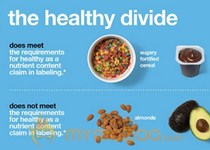This past March, KIND received a warning letter from the FDA. The FDA asked KIND to make adjustments to the packaging language on four of its snack bars, as well as on its website – including removing the word healthy in certain instances. This is because the fat content in some KIND bars exceed the amount allowed under the FDA’s current standard.
During the original broadcast, it was incorrectly reported that KIND was asked by the FDA to remove its products from store shelves – this was not the case.
It was also inaccurately stated that it is hard to find out how much fat is in KIND bars. This also is not correct – the amount of fat in all KIND Snacks are clearly indicated on the Nutrition Facts Panels.
During the original broadcast, Dr. Samadi had commented that “If (food) is over 3 g of fat, it’s not healthy.” It is important to point out that 3 g of total fat and 1 g of saturated fat is the FDA’s limit for using the regulatory term healthy. However there are many foods that exceed this amount and are considered good for you including nuts, salmon, and avocado.
The fat in KIND bars come mostly from nuts, which are high in monounsaturated fats (good fats) and there is an overwhelming body of scientific evidence supporting the benefits of eating nuts.
The FDA’s current regulations were introduced more than twenty years ago. However, today many foods that contain monounsaturated fats (good fats) are recommended for increased consumption by the Dietary Guidelines and leading health & nutrition experts.
Just because a food is low in fat does not mean that it is nutritious. Under current regulations, foods such as low fat chocolate pudding and certain sugary cereals could label their foods as healthy. This means that manufacturers could market products that are low in fat, but otherwise lack any nutrient density, as healthy.
On December 1st, KIND issued a petition urging the FDA to better align its nutrition labeling regulations with the latest science and current dietary guidance, particularly when it comes to using the word healthy.
The effort was being supported by 15 of the world’s foremost authorities in nutrition and public health including experts from Tufts and Harvard.










